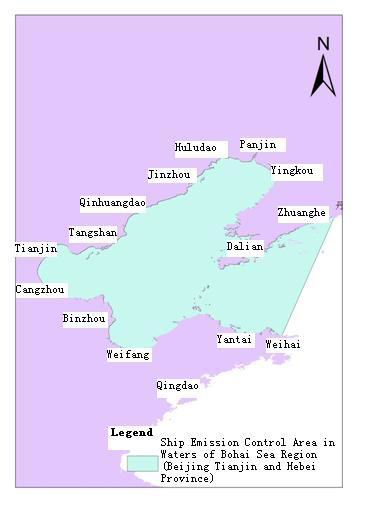
 The Chinese Ministry of Transport has recently announced the introduction of measures to reduce harmful emissions from shipping on the Chinese coast. Three emission control areas are being established in the Zhujiang (Pearl River) Delta, the Yangtze River Delta, and in the Bohai Sea.
The Chinese Ministry of Transport has recently announced the introduction of measures to reduce harmful emissions from shipping on the Chinese coast. Three emission control areas are being established in the Zhujiang (Pearl River) Delta, the Yangtze River Delta, and in the Bohai Sea.
The new regulations will apply to all commercial trading vessels from 1 January 2016. To comply with the new requirements, vessels are to use fuel oil with a sulphur content of no more than 0.5% m/m, or other equivalent measures to reduce emissions including exhaust gas scrubbing, alternative clean fuels and shore power (cold ironing).
The new emission control areas are being established in the following three locations:
1. Zhujiang (Pearl River) Delta (see map)
Sea zones: within an area bordered by a line connecting a point on the coast midway between Huizhou and Shanwei, which extends 12nm offshore, passing 12nm from Zhentouyan, the Jia Peng Islands, Wei Jia Island and Da Fan Shi Island, to 12nm from a point on the coast midway between Jiangmen and Yangjiang, then to this point on the coast. (Excluding the waters of Hong Kong and Macau.)
Inland waters: the navigable waters under the administrative jurisdiction of 9 cities: Guangzhou, Dongguan, Huizhou, Shenzhen, Zhuhai, Zhongshan, Foshan, Jiangmen and Zhaoqing.
Key ports: Shenzhen, Guangzhou and Zhuhai.
2. Yangtze River Delta (see map)
Sea zones: within an area bordered by a line connecting a point on the coast midway between Nantong and Yancheng, which extends 12nm offshore, passing 12nm from Wai Ke Jiao Island, Sheshan Island, Hai Jiao, Southeast Reef, the Yashan Islands, and the Taizhou Islands, to 12nm from a point on the coast midway between Taizhou and Wenzhou, then to this point on the coast.
Inland waters: the navigable waters under the administrative jurisdiction of 16 cities: Nanjing, Zhenjiang, Yangzhou, Taizhou, Nantong, Changzhou, Wuxi, Suzhou, Shanghai, Jiaxing, Huzhou, Hangzhou, Shaoxing, Ningbo, Zhoushan and Taizhou.
Key ports: Shanghai, Ningbo-Zhoushan, Suzhou and Nantong.
3. Bohai Sea (see map)
Sea zones: within an area to the West of a line connecting the coast at Dandong in the North to Weihai in the South.
Inland waters: the navigable waters under the administrative jurisdiction of 13 cities: Dalian, Yingkou, Panjin, Jinzhou, Huludao, Qinghuangdao, Tangshan, Tianjin, Cangzhou, Binzhou, Dongying, Weifang and Yantai.
Key ports: Tianjin, Qinhuangdao, Tangshan and Huaye.
The implementation of the new requirements will take place in five stages:
From 1 January 2016
The ports in the emission control areas may require vessels to use fuel oil with a sulphur content not exceeding 0.5% m/m, or equivalent emission reduction measures, when at a berth (taken as being either at anchor or alongside, with an allowance of one hour after arrival, and one hour prior to departure for fuel oil change over). Other emission reduction measures may also be required. At the present time it would appear that MARPOL requirements will apply in the new emission control areas until 1 January 2017, whilst measures are being taken to ensure sufficient supplies of low sulphur fuel oil in the affected ports. Members are, however, advised to contact their local agents prior to arrival to enquire of any particular local Maritime Safety Agency emission reduction requirements in the three new emission control areas, in particular if proceeding to one of the 11 key ports.
From 1 January 2017
While at a berth in a key port within an emission control area, vessels are to use fuel oil with a sulphur content not exceeding 0.5% m/m, or equivalent emission reduction measures.
From 1 January 2018
While at a berth in any port within an emission control area, vessels are to use fuel oil with a sulphur content not exceeding 0.5% m/m, or equivalent emission reduction measures.
From 1 January 2019
Vessels within an emission control area are to use fuel oil with a sulphur content not exceeding 0.5% m/m, or equivalent emission reduction measures.
By 31 December 2019
The authorities are to evaluate the impact of the forgoing mandatory requirements and may implement additional emission reduction measures. Further requirements may include (a) the use of fuel oil with a sulphur content not exceeding 0.1% m/m, (b) an enlargement of the emission control areas, and/or (c) other measures and initiatives.
Although the new provisions do not address penalties for non-compliance with the emission control requirements, existing Chinese legislation provides for fines of between RMB 10,000 (approx. USD 1,550) and RMB 100,000 (approx. USD 15,500) when a vessel does not use the required fuel oil. Vessels that do not have Bunker Delivery Notes onboard for a period of three years, or a fuel oil sample for one year after bunkering, can be fined between RMB 2,000 (approx. USD 310) and RMB 10,000 (approx. USD 1,550).

Source: Hai Tong and Partners














